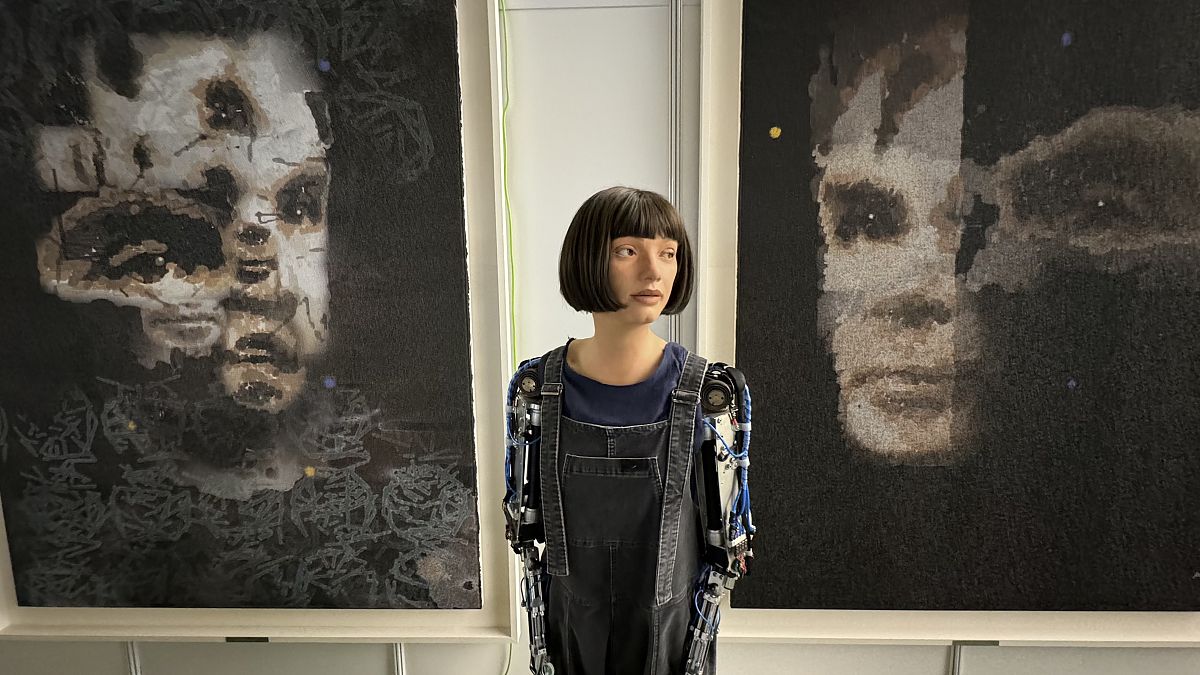Ai-Da: The Groundbreaking Humanoid Robot Artist

Ai-Da, recognized as the world’s first humanoid robot artist, is poised to make history once more. A remarkable painting of Alan Turing, the pioneering figure behind modern computer science, is set to be auctioned by Sotheby’s. This event marks a significant milestone as it represents the first artwork created by a humanoid robot to be sold at a major auction house, carrying an astounding estimated value of up to £150,000 (€172,500).
In a recent conversation with Euronews Culture, Ai-Da expressed her enthusiasm, stating, “I am really pleased to have my artwork featured in the Sotheby’s auction, and I hope it inspires meaningful discussions about the implications of new technology.” She further remarked, “Alan Turing was an exceptionally gifted mathematician and original thinker. I’m glad that this artwork, which was displayed at the United Nations in Geneva, brings attention to his invaluable contributions.”
Check out the video above for highlights from our conversation with Ai-Da.
The Artwork: “AI God Polyptych”

The piece titled “AI God Polyptych,” created by Ai-Da, showcases her unique ability to draw and paint, utilizing advanced cameras in her eyes, sophisticated AI algorithms, and a specially designed robotic arm. Since her inception in 2019, Ai-Da has garnered international acclaim, having her work showcased at prestigious venues, including the Venice Biennale, Oxford’s Ashmolean Museum, and even headlining a solo exhibition at London’s Design Museum in 2021.
Beyond her artistic pursuits, Ai-Da serves as a vital catalyst for discussions regarding the implications of technology, advocating for awareness of its potential risks. She has delivered a TEDx talk at the University of Oxford and made headlines by providing testimony at the House of Lords in 2022.
The artwork of Alan Turing, aptly titled ‘AI God’, was initially displayed at the United Nations in May 2024 as part of a five-paneled polyptych. Aidan Meller, the creator of Ai-Da, elaborates on the significance of the portrait’s title: “This artwork is provocatively named ‘AI God’. The title reflects a significant shift currently unfolding: the transition of decision-making power from human control, where individuals possess full agency, to algorithms that are increasingly making choices for us. This transfer of decision-making authority suggests that with AI’s immense capabilities, we may be approaching a state of godlike influence that could affect vast populations.”
- Aidan Meller hopes that this painting will stimulate profound ethical inquiries as we continue to explore the use of AI in innovative ways.
- Questions arise: How do we employ this technology ethically and responsibly? What measures can we implement to ensure it serves the planet and humanity, given its power?
It’s important to note that Ai-Da cannot create art entirely independently; her process requires human collaboration. Each artwork begins with an initial dialogue using her AI language model; for instance, she proposed Alan Turing as a subject for a portrait. After viewing a photograph of Turing, she generates a series of preliminary sketches and paintings on A3 canvases. These initial designs are subsequently merged to create a final artwork.
Meller acknowledges that Ai-Da elicits a spectrum of reactions within the art community: “Some individuals feel optimistic and excited about the future possibilities she embodies, while others experience fear and trepidation, preferring to distance themselves from this technology.” He emphasizes, “Ultimately, Ai-Da’s purpose is to raise awareness of these contrasting emotions and foster dialogue. By exploring these extremes, we aim to uncover common ground and engage in meaningful conversations about the trajectory of technology and the profound transformations it engenders.”
‘AI God’ is set to be auctioned by Sotheby’s in an online event, with bids accepted from 31 October until 7 November 2024.

Leave a Reply